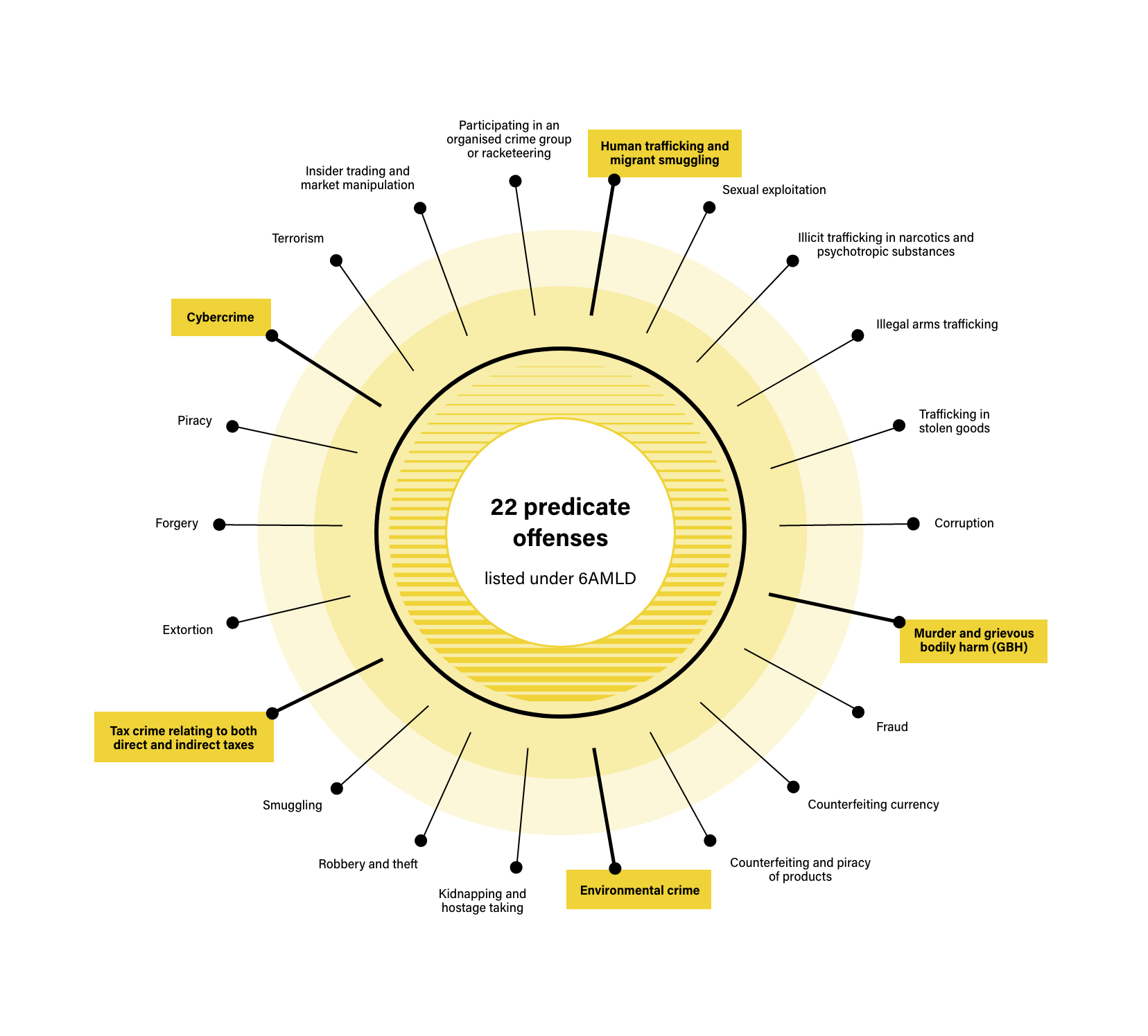

The EU has long tried to determine which predicate offenses drive money laundering. With the latest anti-money laundering directive set to be transposed into law in December 2020, many new predicate offenses will need to be monitored by regulated businesses—screening for them without a sufficient solution will be difficult.
The Sixth Anti Money Laundering Directive (6AMLD) is the first EU AMLD to present a precise and consolidated list of all relevant predicate money laundering offenses, including many new predicate offenses that had previously featured as criminal offenses in EU legislation. It is certain to impact adverse media screening (AMS).
For those unfamiliar with the term, a predicate offense refers to a crime that generates money and occurs prior to money laundering or terrorism financing.
Although the directive is directed at the governments of member states of the EU and does not need to be transposed into national law until 3 December 2020, the increasing focus on the sources of the proceeds of crime is an important trend in the EU and other jurisdictions. For example, the New York Department of Financial Services (NYDFS) Rule 504 of 2017 stipulated that screening and transaction monitoring platforms should be configured not only for the core offenses of money laundering and terrorist financing but also for their predicates, where typological behaviors could be identified.
The increasing focus on predicate offenses will impact the future of how AML controls are implemented and will make businesses consider screening for links to predicate offenses when onboarding and monitoring customers.
Predicate offences on the surface
Previously, the EU has taken a relatively piecemeal approach to the definition of predicate offenses. The 1st AMLD focused primarily on the drug trade, and over time, other offenses such as corruption, involvement in organized crime, and tax evasion were added to subsequent directives. By 5AMLD, however, there was a clear sense that the variety of predicate offenses across different EU jurisdictions was creating problems for inter-FIU and cross-border inter-agency cooperation on international crime; some member states were appearing less open to cooperation where the predicate was not an offense in their own country.
6AMLD does not specifically mandate that obligated entities look for these crimes in their client books or from new customers, but preexisting CDD requirements imply the necessity of a full understanding of who the customer is and the potential character of the business relationship. 4AMLD also states that businesses should report activity that is suggestive of money laundering and “associated predicates,” suggesting that firms should be monitoring for them, too. Part of the difficulty with this is that monitoring for predicate crimes in transactional behaviors is difficult to do. Therefore, to the extent that businesses are looking for potential links to predicate criminality, this has to come via some form of screening process in addition to transaction monitoring.
The codification of the 22 predicate offenses changes the tone of the debate because it puts predicate criminality back at the forefront of AML—the detection, disruption, and prevention of crimes that help criminals make money.

In the future, businesses that need to meet this more comprehensive approach to predicate offenses must consider the wide-ranging aspects of compliance. Onboarding checks and controls must be carefully calibrated to ensure that they are not bringing a wider range of criminals than before. This suggests the need for more work for compliance teams, first through the identification of businesses’ potential exposure to particular predicate crimes through an enterprise-wide risk assessment, the reconfiguration of controls, and then the execution of the controls and checks at the end of the process. Depending on the character and scale of a firm’s current AML framework, that might imply considerably lengthier checks than previously undertaken will be required.
This will prove a challenge for many businesses that are reliant on keyword-based checks, Google, and ad hoc solutions during onboarding, client risk assessments, and event-driven reviews. Even with a limited range of offenses to consider, this is a lot of work for a team of human analysts. And with 22 specific offenses to consider, with all their permutations, it will be challenging for a truly diligent obligated entity to be able to hit their onboarding targets once 6AMLD is fully transposed into national laws without an adverse media screening provider that can effectively assist in these goals. Especially once regulators start asking questions about what controls firms have in place to cover these risks.
Identifying predicate offenses related to your customers will be critical for compliance functions going forward.
Search strings and keywords in adverse media screening
What to do about this challenge?
Not much guidance is available on Adverse Media Screening (or Adverse Information and Media) from regulators. They want to make sure that you’re not missing out on relevant adverse media, but they do not necessarily have the expertise to tell you how to do that. The Monetary Authority of Singapore (MAS) and Hong Kong Monetary Authority (HKMA) are notable exceptions that provide robust and workable guidance for the use of adverse news with respect to transaction monitoring.
Search strings (a list of keyword numbers and operators meant for finding specific results) are already recognized as inefficient in identifying risks that don’t sit neatly on sanctions screening and PEP lists. It takes a long time, especially when an analyst can only search against 32 keywords in Google, including the variations of those keywords, at a time.
Using this approach is a low-likelihood way to try to isolate whether or not someone may pose a risk to a business. Moreover, search strings themselves are often not used consistently across multiple analysts or stored in secure or appropriate ways; in fact, they are often saved in an analyst’s personal Word document as a long, complex mass of variations, exclusions, and Google hacks.
The level of weight and prominence that 6AMLD gives to so many predicate offences indicates that manual Adverse Media Screening is unlikely to be a viable path and is arguably already out of date unless firms wish to drastically lengthen the time taken to onboard or review customers, risking alienating them as a result. An automated AMS platform is the most efficient, secure, and auditable way to approach the problem.
However, it is not as simple as just buying a platform. Unfortunately, most adverse media screening platforms are using keywords, too—it is automation but without context. Although there are fewer compliance officers, those who remain will probably not be aware that their solution is missing out on nuanced variations and clever replacement words that can enhance their searches.
The positive news is that there are more intelligent approaches to adverse media screening, which are able to understand the nuance of language through Natural Language Processing (NLP) techniques, which use machine learning to develop and compile a database of adverse entities. NLP-powered tools can search through millions of pages of news made available on the internet daily and refer back to billions of pages that have already been indexed to create this comprehensive database of individuals and organizations.
Coverage and configurability are also vital. Platforms must allow firms to search for a customer based on their personal information (full name, date of birth, etc.) and receive a profile that compiles all their relevant adverse media into one location. More importantly, they need to be able to take a risk-based approach (RBA) to collate adverse media relating to relevant predicate offenses. Configurable solutions are the only way forward for new risks and predicate offenses.
The power of profiles and future-proofing
According to internal policy, customer profiles compiled by adverse media screening platforms should relate to all the predicate offenses plus any other crimes included in your RBA. Screening for adverse media related to these offenses will allow compliance officers to justify, monitor, and reject customers more thoroughly, depending on your business’s policies.
Compliance officers encounter and must assess a constellation of risks, a series of weak signals that are often discussed as distinct issues but are, in reality, interconnected. When combined into a profile, Adverse media combines many of these weak signals into a singularly powerful asset in determining whether or not a customer or potential customer poses a significant risk to the business.
We don’t know what the future holds, but we can take precautions based on what has happened before. The renewed focus on predicate offenses in the EU, FATF, and elsewhere appears to be part of a trend businesses must take seriously. Codifying 22 offenses in one directive is significant, and there is every possibility that more will come with further changes to the regulations.
Businesses need to get ahead of the game, and integrating an adverse media screening platform that can easily be configured for new predicate offences and constantly compiles profiles is a robust way to prepare.
There is significant risk in putting your business into a position where it is unable to accurately screen for adverse media or have adverse media screening that will be out of date in a matter of years. Future-proofing your compliance functions means that you can focus on making sure customers fit the business’s risk profile, which gives you an advantage when talking to regulators.
No regulators will criticize a firm for doing adverse media screening well, but deficiencies in the event of an audit may negate possible leniencies.
Going forward with adverse media screening
What’s important in the face of 6AMLD is recognizing that non-software adverse media screening solutions are no longer viable. You need to focus on what’s happening right now and the changes that will have an immediate impact. However, compliance teams must keep an eye focused on what’s happening in the industry and what will be occurring soon.
Any adverse media screening platform provider you partner with now must be reconfigurable for future changes. The focus on predicate offenses is going to widen the scope of how we think about AML, and it is more than likely that new predicates will be added over time. Preparing for that possibility now will mean that businesses can weather further compliance changes in the long term.
Improve your organization’s operational efficiency
Fortify your organization and fuel your growth with dynamic solutions tailored to your needs. Book your free demo today and find out why 1000s already use ComplyAdvantage.
Get a demoOriginally published 08 September 2020, updated 03 December 2025
Disclaimer: This is for general information only. The information presented does not constitute legal advice. ComplyAdvantage accepts no responsibility for any information contained herein and disclaims and excludes any liability in respect of the contents or for action taken based on this information.
Copyright © 2025 IVXS UK Limited (trading as ComplyAdvantage).
